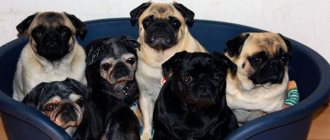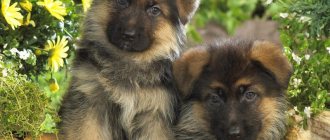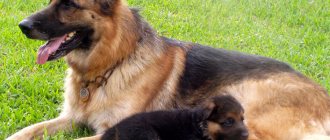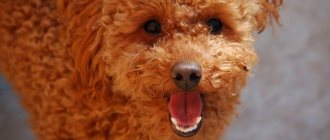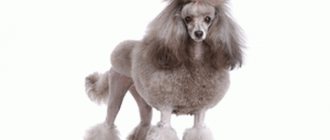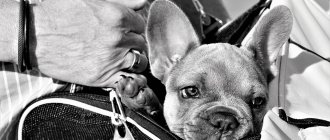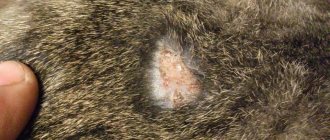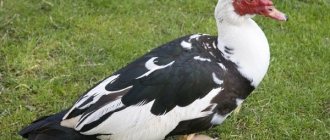Probably many people were interested in getting a German Shepherd. And before choosing, you need to clarify whether you are getting her as a pet or for exhibitions. This will influence the choice of color.
Three genes are responsible for which variant a dog will have:
- A. Responsible for black;
- AW. Responsible for zonal;
- A.T. Responsible for black and tan.
All of them will form the possible color of the dog using the genetics of colors in the German Shepherd. And if the result is a non-standard color, this means that the species has undergone a mutation process. This is considered a defect, and the dog cannot participate in competitions in the future.
Regardless of the color of the German Shepherd, there are other requirements. They touch the nose, chin and undercoat. The following deviations can also be considered as defects:
- There is no mask on the face;
- Light-colored eyes;
- White markings on chest;
- White claws;
- Red tail;
You also need to take into account the length of the coat. The pet can be either short-haired or long-haired. It is impossible to predict what the puppy will be like. The formation of fur length occurs only after several molts. Moreover, it is not recommended to breed dogs with different coat lengths.
Zonar
German Shepherd puppies, which have a zonal color, are distinguished by the fact that they are the very first representatives of the breed. It occurs in ring zones in the following order:
- The base is light.
- Black shade of the zone.
- Yellow zone.
- Black zone.
Thanks to the presence of different options on different parts of the body, you will get an interesting range. Depending on it, there are two types:
- Zonal gray;
- Zonar-red.
This type will dominate over all others. And when crossed with pets of any other colors, the result is zonal. This is due to the fact that black-colored dogs are often allowed into exhibitions. However, this type has several positive features. The percentage of dogs with this shade does not exceed 3%.
- Zone gray
This is one of the most original shades, and all other colors come from it. More often, pets are compared to wolves. A distinctive feature can be noted that there are annular areas with alternating dark and yellow shades. The base will be lighter.
The birth of such puppies is possible if one of the parents is gray in color. If we talk about ability to work, then German Shepherds have the highest.
- Zonar-red
This is a peculiar shade that arises as a result of the dominance of red, black and black. This breed is valued in India, because according to some ancient sources it is believed that the Indian wolf is the progenitor of modern shepherd dogs. Such dogs have increased mobility, and some dog handlers distinguish them as the standard of the breed.
About the history and genetics of the breed – German Shepherd
Since ancient times, wolf-like dogs have accompanied humans, helping to herd livestock, protect homes and hunt. The ancestors of this type inhabited the territory of Germany in the 19th century, engaged in shepherd work. The ancestor of the Old German Shepherds is the bronze dog, which is the result of crossing a European husky and a wolf.
At the 1882 exhibition in Lower Saxony, the first dog of a non-standard color was presented - the off-white Greif dog.
At the end of the 19th century, thanks to the efforts of Captain Max Emil Frederick von Stephanitz, the first "German" was created. The German Shepherd was officially introduced at a dog show in 1899.
The genetics of the German Shepherd have been studied by many cynologists, but questions regarding color unification still remain open.
Many factors must be taken into account during breeding selection. It is undesirable to combine genes and alleles within the breed that are responsible for the color of a German shepherd; each of them carries its own special code. The variety of colors of this breed is due to the presence of melanin pigment.
The color of a German Shepherd is determined by three main genes:
- A – black;
- AT – black and tan;
- AW – zonal.
With the help of these three genes, different colors of dogs are formed. The consequence of gene mutations is the emergence of color variants. Inconsistencies in relation to the norm are defined by dog handlers as marriage.
According to the type of hair, German Shepherds are divided into short-haired and long-haired. A pet's coat is formed only after several molts, so it is impossible to understand what kind of coat a newborn or even a grown-up puppy has.
Black and Tan
Found in fewer cases than black. There are areas of a red tint on the body. Tan is usually located on the eyebrows, chest, legs, and tail. Externally, the coloring is very similar to the Doberman. You can also distinguish black and tan shades by intensity. There are 3 varieties here:
- Saturated;
- Darkened;
- Weakened.
Dogs with black tan are used for working breeding.
Zonar-red color
The zonular red color of the German Shepherd is not recognized by all dog handlers. Although it is included in the list of colors approved by the RKF. It's just that not every dog owner likes this color.
What is he? The animal has a dark gray, closer to black, back, head, upper tail and sides. A “mask” of the same color is acceptable on the face. The front paws, chest, belly, and hind paws are brownish-red in color. Redhead can be found behind the ears and on the face.
Below you can see a photo of a German Shepherd with a zone-red color.
Non-standard colors
You can also find shades that are rare in everyday life. The dogs are considered defective. They do not compete and are not bred. The defect does not affect the state of health or character in any way.
White
White German Shepherd puppies can occur when both parents carry the recessive gene. But puppies cannot be classified as albinos. The dogs have a black nose, dark eyes and claws.
Roan
Sometimes, as a dog ages, he may turn grey. Light hairs will appear on the fur, and dark hairs will gradually disappear. When gray hair predominates, this is the roan option.
Grey
The color can often be heard called blue. It appears when the black color weakens. All puppies are immediately culled.
Spotted
The entire body is covered with multiple spots of different shades. They are scattered unevenly. The color is obtained by crossing individuals of different shades.
Red yellow
This is another non-standard look that looks very interesting. But German Shepherds of this color cannot be used for competitions. At the same time, zonal red may be allowed.
Golden
This type of red shade occurs when a certain pigment appears. The coat will be light and almost golden.
No matter how much you want to get a pet with some interesting color, you need to remember that the animal will not be recognized as standard. It can only be kept as a pet. If you want to take part in some exhibitions or in further breeding, then you need to take a dog with the desired color.
Acceptable colors: names and photos
According to the standard, 3 types of colors are possible for a purebred German Shepherd: black-and-white, zoned and black. Black and tan is distinguished separately, but it cannot be positioned as an independent type. This suit is just a variation of the main colors.
Cheprachny
The most common type, found in 90% of individuals. Such dogs have a V-shaped black spot on their back, which extends to the sides, belly, top of the tail and can extend to the elbows.
The bottom is painted in a light color. It grabs the stomach, chest, neck, paws. Various shades are allowed:
- fawn (yellow);
- grey;
- brown (chocolate).
A prerequisite is a black mask. It covers the animal's face and ears.
Defects are considered to be the absence of a mask, if it is weakly expressed, or a “saddle cloth” of an unsaturated color. The shade of tan can be any, but darker tones are preferable.
When buying a black-backed puppy from a kennel, you must take into account that it will become lighter in color with age.
Zonar
Considered a rare type. Only 5% of “Germans” have this suit. The color arises from the interesting color of the coat: it is light at the base, then dark, then yellow, and black at the tips.
The zone suit is also called wolf, grey, gray or agouti.
The muzzle, back and tail are the most intensely colored. Saturation weakens on the sides and on the paws.
Any shades are acceptable - from rich brown to light yellow. But under one condition: the structure of the color should not be disturbed.
The zonal color gene is always dominant. It is curious that it is impossible to get a puppy of this color if you cross two “zonars” - the babies will be black or black.
Black
The name speaks for itself. These “Germans” have a luxurious all-black fur coat.
This is the rarest variety provided for by the standard. According to various sources, it occurs in only 3% to 5% of dogs.
A deviation is considered to be an inclusion of any other shade. White spots, markings, light claws and nose are not allowed.
If the puppy is born with a completely black coat, its color will not change during shedding.
Black and Tan
It is sometimes distinguished as a separate type, but in fact it is a variety of other suits. A dog with this color will be almost black, with the exception of brownish-red patches on the belly and on the inside of the paws. Light eyebrows, chest and cheekbones are also allowed.
Unlike pure black, dark tan can lighten over time. In addition, it weakens from litter to litter.
Life expectancy and health
Zonal “Germans” live on average from 10 to 14 years.
These are fairly healthy dogs, but, nevertheless, they may be prone to certain diseases , such as :
- Hip dysplasia.
- Allergy.
- Pathologies of the digestive organs.
- Skin diseases such as dermatitis or eczema.
- Otitis.
German shepherds are very sensitive to serious infections, so it is recommended that the dog receive all necessary vaccinations on time, after which the pet should not be taken outside until the end of quarantine.
Dimensions, weight and other distinctive features
The height of males is 60-65 cm, and the weight is 30-40 kg. Bitches are somewhat smaller: their height is 55-60 cm, and their weight is 22-32 kg.
The body format is slightly stretched. The size of the head is slightly less than half the height at the withers. The lengths of the cranial part of the head and muzzle are related to each other in a 1:1 ratio. The head is wedge-shaped: being noticeably wider at the top, it tapers towards the tip of the nose.
The ears are not long, but rather wide at the base, having the shape of a triangle.
According to the breed standard, the German Shepherd should have forward-facing, high-set, erect ears with moderately pointed tips .
The eyes are medium-sized, almond-shaped, preferably as dark a brownish shade as possible. The gaze of the zonal shepherd is attentive, lively and quick-witted.
The nose is large, with exclusively black pigmentation.
The neck is of medium length, strong and muscular, without dewlap. It is placed at approximately an angle of 45 degrees, when alert it rises slightly, and when running it is placed lower.
The withers are well defined, the back is quite wide and strong, sloping from the withers towards the croup.
The chest is deep and moderately wide: its depth ranges from 45 to 48% of the height at the withers.
The forelimbs are straight, even and parallel, the hind limbs are muscular, having a slightly shorter length than the forelimbs.
The tail is saber-shaped, slightly curved, and can rise slightly when excited.
The coat can be either quite short and stiff, or longer and relatively soft . Some long-haired shepherd dogs do not have a very well developed undercoat.
Pigmentation of the muzzle
A special dominant gene is responsible for the black mask (muzzle before and around the eyes), which gives the shepherd dog the expressiveness of the breed. A well-pigmented German Shepherd may have a weakened mask, while a lightly colored one, on the contrary, may have a strong mask.
Dark areas of the eyebrows/forehead are linked to the base color at the genetic level: a dog with an expressionless saddle coat often shows a light forehead, while a deep black mantle “attracts” a black forehead. The unmasked Black and Tan Shepherd resembles a Doberman Pinscher - it has a black muzzle, brown throat and liver-shaped lips. A dog with a zonular color has a sable tint to the eyebrows.
Return to content
Varieties of shades
Zone colors are divided into two main groups: zone-gray and zone-red.
In the first case, the dog has only hairs with gray and black pigments, and in the second there is also a pigment of reddish shades.:
- Zone-gray colors : gray of varying intensity, gray-black and black-gray, gray-black with a mask, dark gray with a mask, dark gray with a pronounced dark stripe on the back.
- Zonar-fawn colors : grayish-yellow, grayish with brown and black patina, grayish-brown, grayish-brown with black markings on the limbs and fingers, gray mask with brownish spots on the head and legs.
Until the dog is three years old, the zonular color can change its saturation and intensity.
